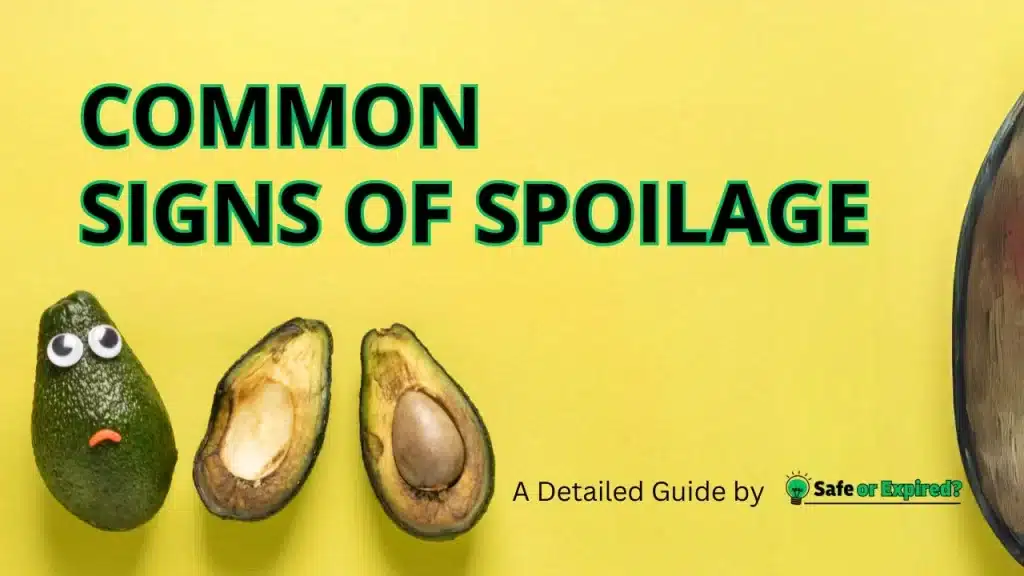Have you ever wondered if the food in your fridge is still safe to eat? Spotting the common signs of food spoilage, from odors to strange textures, can save you from trouble. In this guide, I’ll walk you through the key indicators that your food might not be at its best. Stay informed and ensure your meals are always fresh and safe to enjoy.
9 Common Signs of Spoilage – Backed by Science
Common signs of food spoilage include odors, color changes, texture changes, mold growth, taste alterations, swelling or bulging packaging, leakage, insect infestation, and past expiry dates. Recognizing these indicators can help you determine if food is unsafe to eat, ensuring you maintain food safety and prevent foodborne illnesses.
1. Off Odors
| Factor | Details |
| Signs to Look For | Unpleasant, sour, or rancid smells |
| Commonly Affected Foods | Milk, Cheese, Meat, Poultry, Fish |
| Causes | Bacterial, yeast, or mold growth |
| Health Risks | Foodborne illnesses due to harmful microorganisms |

Off odor is one of the first and most reliable signs that your food has begun to spoil. Whether it’s a carton of milk, a piece of meat, or leftovers from dinner, an unpleasant smell is a clear signal that bacteria, yeast, or mold have started to grow in the food. These microorganisms break down food components, producing gasses and chemicals that give off those telltale bad smells.
You may be wondering, “Why do spoiled foods smell bad?” The reason spoiled foods emit bad odors is due to the metabolic processes of bacteria and fungi. As they digest the food, they produce compounds like sulfur, ammonia, and amines, which have strong and often unpleasant odors.
For instance, meat that smells rotten has usually been affected by bacteria-producing sulfurous compounds, contributing to that unmistakably bad “off” smell.
Sometimes, you may also see fungi spots on the food that smell bad, according to Science Direct. Below is an image of a spoiled carrot that has visible signs of mold growth.
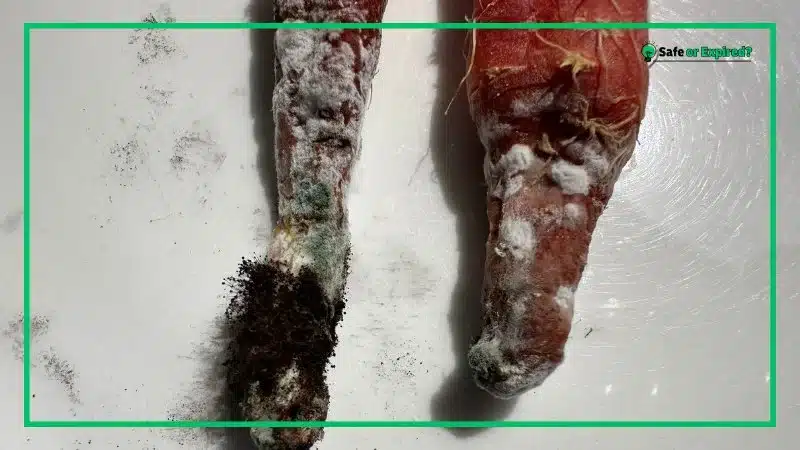
Your sense of smell is a powerful tool for detecting food spoilage. If something smells “off,” it’s usually best not to taste it. The smell alone can indicate the presence of harmful microorganisms that could cause food poisoning.
Here are examples of off-odors
- Sour Milk: Like vinegar or sour cream, but much more unpleasant.
- Rotten Meat: A putrid smell, similar to sulfur or rotten eggs.
- Spoiled Fish: A strong, fishy odor that’s much more intense than fresh fish.
- Overripe Fruit: May smell fermented, alcoholic, or vinegar-like.
2. Color Changes
| Factor | Details |
| Signs to Look For | Discoloration, fading, or unnatural color spots |
| Commonly Affected Foods | Meat, Fruits, Vegetables, Dairy Products, Fish |
| Causes | Oxidation, bacterial growth, chemical reactions |
| Health Risks | Potential for consuming spoiled or toxic food |

When you’re checking if food is still good to eat, one of the first things you might notice is its color. Color changes in food can be a clear indicator that it’s time to toss it out. Just like off odors, changes in color are often a sign that microorganisms have started to grow in your food or that chemical reactions have occurred, altering its original hue. It’s nature’s way of signaling that something isn’t quite right.
According to a review in MDPI, color changes in food occur for a variety of reasons. Bacteria, yeast, and molds can cause visible changes as they grow. For example, the surface of meat may turn green or brown, and fruits and vegetables may fade or darken.
Certain chemical reactions, such as oxidation, can also change the color of food without the presence of microorganisms. While not all color changes indicate spoilage (think of an apple turning brown when cut and exposed to air), many do signal that the food is no longer safe to eat.
Spotting color changes is crucial to extend the food’s shelf life. Here’s what to remember:
- Meat, Poultry, and Fish: Fresh meat should have a bright, consistent color. Spoilage may cause beef to turn green or brown, chicken to become dull or yellowish, and fish to develop a milky, opaque appearance or a yellowish discoloration.
- Fruits and Vegetables: Fresh fruits and vegetables display vibrant colors. Spoilage can result in fading, browning, or dark spots. Leafy greens may turn yellow or slimey, indicating decay.
- Dairy Products: Milk doesn’t show much color change, but cheeses can develop orange or pink spots of mold, which are signs of spoilage.
Understanding what specifically causes food to spoil can help you better prevent it. For an in-depth look at the various factors, read “Factors Affecting Food Spoilage: 15 Culprits That Spoil Food.”
3. Texture Changes
| Factor | Details |
| Signs to Look For | Sliminess, mushiness, or unusual firmness |
| Commonly Affected Foods | Meat, Dairy Products, Fruits, Vegetables, Fish |
| Causes | Enzymatic breakdown, microbial activity |
| Health Risks | Ingesting harmful bacteria or toxins |
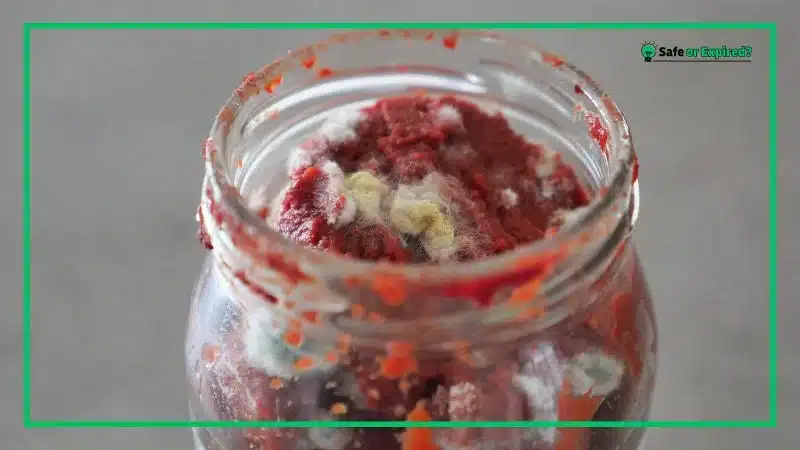
According to an editorial article in Frontiers, texture changes are a tactile indicator that a food item may have seen better days. From sliminess on your favorite deli meats to the unexpected mushiness of fruits and vegetables, changes in texture can be a clear sign that food spoilage is underway.
Want to know why texture changes occur in food? Microorganisms such as bacteria, yeast, and molds play a significant role in altering the texture of food as they grow. These tiny invaders can produce enzymes that break down food’s structural components, leading to softening, liquefaction, or increased firmness in some cases.
Additionally, improper storage conditions can accelerate these changes, making the texture a critical factor to consider when assessing food quality. If you’re interested in knowing how you can store raw food correctly, then read this guide on Easiest Tips to Store Raw Food.
Here are the examples of texture changes in spoiled foods:
- Meat, Poultry, and Fish: Fresh meat should be firm and slightly moist. When spoiled, it may become slimy or excessively sticky, indicating bacterial growth.
- Fruits and Vegetables: They should be firm and crisp according to their nature. Spoilage can turn them mushy or slimy, especially in areas of bacterial or fungal invasion.
- Dairy Products: Products like yogurt and soft cheese have a smooth, creamy texture. Spoilage can cause them to separate, become lumpy, or develop a watery layer.
Texture changes often accompany other spoilage signs, such as off odors and color changes, providing a multi-sensory approach to evaluating food safety. However, relying solely on texture can sometimes be misleading, as certain foods naturally soften with age without necessarily spoiling. Hence, it’s essential to consider texture alongside other spoilage indicators.
4. Mold Growth
| Factor | Details |
| Signs to Look For | Visible mold, fuzzy growth, spores |
| Commonly Affected Foods | Bread, Cheese, Fruits, Vegetables, Jam |
| Causes | Fungal growth in moist, warm conditions |
| Health Risks | Allergic reactions, mycotoxin exposure |
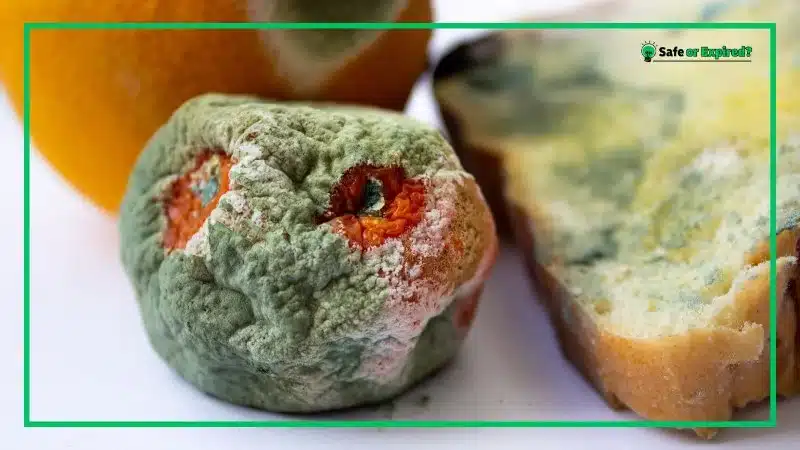
Spotting mold on your food is like seeing a big, red stop sign. It’s one of the most visible and undeniable signs that food has spoiled. According to the Journal of Food Protection, mold growth can range from small, speckled spots to large, fuzzy patches, and it comes in various colors, including green, white, black, or even pink.
But what causes mold to grow on food? Well, moist, warm conditions. Mold’s spores float through the air, landing on surfaces and waiting for the perfect conditions to grow. Once it finds a hospitable environment (like that leftover slice of bread or ripe piece of fruit), it starts to spread, breaking down the food for nutrients. According to USDA, moldy food can be dangerous to consume. Therefore, discarding it is recommended.
Dr. Jae-Hyuk Yu(PhD) from The Food Research Institute – University of Wisconsin-Madison provides an overview of molds, mycotoxins, and associated industry concerns in this guide. She explained that the best approach to prevent fungal spoilage of food is to try to stop entry of fungi if possible.
Tips on identifying Mold for various foods.
- Bread and Baked Goods: Mold appears as fuzzy, colored patches. Green and white are the most common colors.
- Cheese: Some cheeses are meant to have mold, but unwanted mold can appear on cheese surfaces or within the cheese itself, often showing up as blue or black spots.
- Fruits and Vegetables: Look for fuzzy textures or discolored spots that seem to sit on the surface of the produce.
Knowing how food safety authorities globally ensure the safety of your food can offer additional peace of mind. You can learn about it by reading the article 7 Food Safety Authorities That Protect Our Foods.
5. Taste Changes
| Factor | Details |
| Signs to Look For | Altered, sour, or rancid flavors |
| Commonly Affected Foods | Dairy Products, Meat, Poultry, Canned Goods, Fish |
| Causes | Bacterial growth, chemical degradation |
| Health Risks | Risk of food poisoning and gastrointestinal discomfort |
Tasting your food is often the last step in determining its freshness, and significant changes in taste can be a telltale sign that something’s not quite right. Taste changes in food are primarily caused by the growth of bacteria, yeast, and mold. These microorganisms can produce substances as they break down food compounds, which can significantly alter the taste.
Chemical changes, such as oxidation, can also affect the flavor of food, making it taste rancid, especially in fats and oils.
However, tasting should be your last line of defense in detecting spoilage. Eating even a small amount of spoiled food can lead to foodborne illness, so if you’re already noticing off smells, color changes, or any visual signs of mold, it’s not worth taking the risk just to confirm by taste.
Here are some examples of taste changes due to spoilage.
- Sour Milk: Beyond just a slight tanginess, indicating it’s beginning to turn.
- Rancid Nuts: They have a sharp, bitter taste compared to their normally mild, creamy flavor.
- Off-Tasting Canned Vegetables: An unusual or metallic taste can indicate spoilage or contamination.
6. Swelling or Bulging Packaging
| Factor | Details |
| Signs to Look For | Packaging that is swollen, bulging, or deformed |
| Commonly Affected Foods | Canned Goods, Jarred Goods, Sealed Packages |
| Causes | Gas production by bacteria, contamination |
| Health Risks | Botulism, other serious foodborne illnesses |
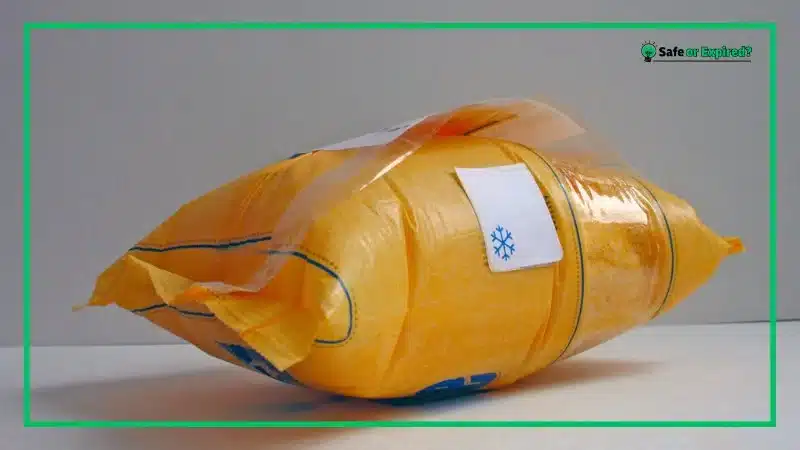
When you pick up a can, jar, or any sealed food package and notice it’s swelling or bulging, it’s like a flashing warning light telling you something is off. Note that swelling or bulging occurs when gas is produced inside a sealed package, a byproduct of bacterial growth.
Certain bacteria, such as Clostridium botulinum, which can cause botulism, thrive in low-oxygen environments and can produce gas as they multiply. The pressure from this gas builds up, causing cans, jars, and even plastic packaging to swell or bulge. This is not just a sign of spoilage but a potential health hazard.
Spotting swollen or bulging packaging:
- Canned Goods: Any can that appears swollen or feels too firm to the touch is suspect. The same goes for cans that spurt liquid when opened—a sign of excessive pressure build-up.
- Jarred Goods: Lids on jars that are convex or pop when unsealed indicate gas build-up inside.
- Vacuum-Packed and Sealed Plastics: Packages that have lost their vacuum seal or appear puffed out should be viewed with suspicion.
Beyond the obvious spoilage, swollen or bulging packaging can indicate the presence of dangerous bacteria that pose serious health risks, including botulism, a life-threatening illness. Consuming food from such packages can be extremely hazardous, so it’s best to err on the side of caution.
So, what to do with swollen or bulging food packaging?
- Do Not Taste: Given the potential risks, tasting food from swollen or bulging packaging is out of the question.
- Safe Disposal: To avoid potential exposure to toxins, dispose of these items in a way that prevents others from retrieving and consuming them.
- Clean-Up: If a bulging can or jar has leaked, clean the area thoroughly to prevent cross-contamination with other foods or surfaces.
7. Leakage
| Factor | Details |
| Signs to Look For | Liquid or residue outside the packaging |
| Commonly Affected Foods | Canned Goods, Packaged Meat, Dairy Products, Beverages, Condiments |
| Causes | Package damage, seal failure |
| Health Risks | Exposure to pathogens, increased risk of contamination |
Leakage from food packaging is a clear signal that the integrity of the product has been compromised. Whether it’s a can, a plastic bag, or a jar, any sign of leaking suggests that the seal meant to protect the food inside has been broken. This can lead to contamination and spoilage, posing a risk to food safety.
Leakage can result from a variety of issues, including;
- Physical damage to the packaging
- Manufacturing defects
- The internal pressure (caused by gas produced by bacteria within the package).
When the protective barrier is breached, microorganisms from the outside environment can enter and contaminate the food. This leads to spoilage and the potential for foodborne illness.
Here’s how to detect leakage in food packaging.
- Canned Goods: Look for any liquid on the exterior of the can or underneath it on the shelf. Any sign of rust or corrosion can also indicate potential leakage.
- Sealed Bags and Pouches: Liquid or residue outside of sealed bags or pouches is a red flag. The packaging should also feel firm; any bloating could indicate internal spoilage.
- Jars and Bottles: Sticky residues or drips on the outside of jars and bottles often point to leakage. Check the seal and lid for any signs of damage or looseness.
Here’s how to handle leaking food packages.
- Assess and Dispose: If you discover leaking packaging, especially with perishable items, it’s safest to dispose of the product.
- Avoid Cross-Contamination: Keep the leaking item separate from other foods to prevent the spread of potential contamination.
- Clean Up: Clean any surfaces or areas where the leaking product was stored to ensure other items and areas remain safe.
8. Insect Infestation
| Factor | Details |
| Signs to Look For | Live or dead insects, larvae, webbing |
| Commonly Affected Foods | Flour, Rice, Pasta, Cereals, Nuts |
| Causes | Poor storage, contamination at any production stage |
| Health Risks | Digestive problems, allergic reactions |
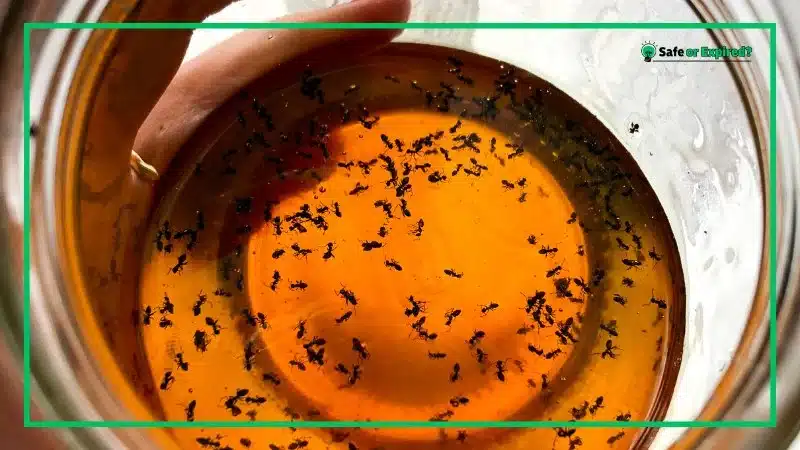
Finding insects in your food or food packaging is a surefire sign that the food is no longer fit for consumption. Whether it’s flour teeming with tiny beetles, rice inhabited by weevils, or any other pantry staple under siege, insect infestation compromises food safety and quality.
Insects can infest food products at any point from the farm to the supermarket shelf, although it most commonly occurs in pantry staples stored for long periods. According to MDPI, these pests not only consume the food but also lay eggs in it, leading to a cycle of contamination that can quickly spread to other stored foods.
Here’s how you can identify insect infestation.
- Visible Insects: The most obvious sign is seeing live or dead insects within the food product or packaging.
- Eggs and Larvae: Tiny eggs, larvae, or webbing inside the package indicate an infestation.
- Damage to Packaging: Holes, gnaw marks, or other damage to food packaging can suggest insects have breached the barrier.
Follow these food safety guidelines when you discover insect infestation.
- Discard Affected Items: To prevent the spread of infestation, immediately dispose of any contaminated food products.
- Inspect Nearby Foods: Check other pantry items for signs of infestation, as insects can quickly move between packages.
- Clean Thoroughly: Clean your pantry shelves, containers, and any other storage areas to remove remnants of infested food and any lingering insects or eggs.
It’s easy to fall prey to common myths that might lead to improper food handling. To ensure you’re not misled, explore the truths in our article “10 Shocking Food Preservation Myths Exposed,” which helps debunk widespread misconceptions.
9. Expiry Date
| Factor | Details |
| Signs to Look For | Products consumed past the printed expiry date |
| Commonly Affected Foods | Dairy, Meat, Poultry, Canned Goods, Ready-to-eat Meals |
| Causes | Degradation over time, loss of nutritional value |
| Health Risks | Foodborne illnesses, decreased food quality |
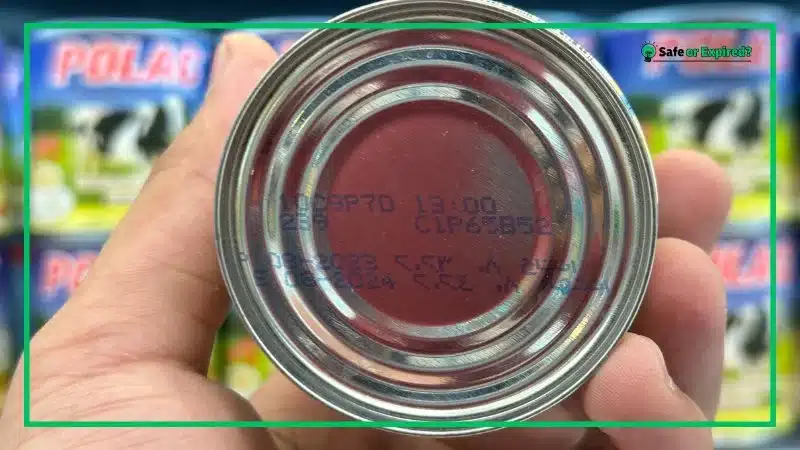
The expiry date on food packaging plays a crucial role in informing consumers about the expected lifespan of a product. It indicates the date until which the food item is anticipated to remain at its best quality, as determined by the manufacturer.
Expiry dates are based on scientific testing and are provided to guarantee the product’s quality and safety. Consuming products past their expiry date can lead to diminished flavor, texture, and, most importantly, nutritional value. Moreover, it may pose risks of foodborne illnesses, especially with perishable items like dairy, meat, and ready-to-eat meals.
Here’s how to handle foods near their expiry date.
- Inspect and Decide: If a product is nearing its expiry date, inspect it for other signs of spoilage like off odors, discoloration, or texture changes. If any are present, it’s best to discard the item.
- Proper Storage: Ensure foods are stored according to manufacturer recommendations to maximize their shelf life.
Note that expiry and best-by dates are not the same. For clarity on ‘expiration’ vs. ‘best by’ dates and their implications, check out “Expiration vs Best By Dates: Key Differences to Know!”
Conclusion
Everyone should know about the signs of food spoilage, as it will help them maintain a safe kitchen and prevent foodborne illnesses. Here’s a quick recap:
- Off Odors: An early warning sign that something’s amiss with your food.
- Color Changes: Visual cues like discoloration can indicate spoilage.
- Texture Changes: Slime or mushiness often means it’s time to toss.
- Mold Growth: Visible mold is a clear sign that food has gone bad.
- Expiry Dates: Always check the date to ensure food is safe to consume.
Now, you can keep your meals delicious and safe, minimizing waste and maximizing enjoyment.

